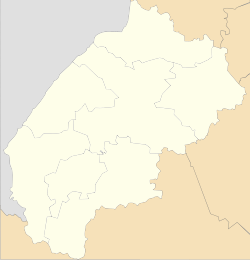Skomorokhy, Lviv Oblast
Skomorokhy
Скоморохи | |
|---|---|
Village | |
| Coordinates: 50°32′06″N 24°19′40″E / 50.53500°N 24.32778°E | |
| Country | |
| Oblast | |
| Raion | Chervonohrad |
| Hromada | Sokal |
| Area | |
| • Total | 1.547 km2 (0.597 sq mi) |
| Elevation | 192 m (630 ft) |
| Population (2001) | |
| • Total | 893 |
| Time zone | UTC+2 (EET) |
| • Summer (DST) | UTC+3 (EEST) |
| Postal code | 80024 |
| Area code | +380 3257 |
Skomorokhy (Ukrainian: Скоморохи) is a village in Chervonohrad Raion, Lviv Oblast of western Ukraine. It belongs to Sokal urban hromada, one of the hromadas of Ukraine.[2]
History
[edit]Skomorokhy is described in detail in the royal lustration of 1565.[3]
The village remained part of Poland until the first partition of Poland, when it was annexed by the Habsburg Empire, as part of Galicia. It was located in the Sokal district, one of the 78 Bezirkshauptmannschaften in the Austrian Galicia province (Crown land) in 1900.[4] After World War I, possession of this province was disputed between Poland and Soviet Russia, until the 1921 Peace of Riga, which attributed Eastern Galicia to Poland. In the Second Polish Republic, Skomorokhy was located in Sokal county in Lwow Voivodeship. On 1 January 1939, 1,320 people lived in the village (1,000 Greek-Catholic Ukrainians, 120 Roman-Catholic Ukrainians, 65 Poles, 130 Polish interwar colonists and 5 Jews).[5] After World War II ended, Skomorokhy was ceded to the Ukrainian SSR in August 1945.[6][7]
Until 18 July 2020, Skomorokhy was located in Sokal Raion. The raion was abolished in July 2020 as part of the administrative reform of Ukraine, which reduced the number of raions of Lviv Oblast to seven. The area of Sokal Raion was merged into Chervonohrad Raion.[8][9]
References
[edit]- ^ "Skomorokhy (Lviv Oblast)". weather.in.ua. Retrieved 11 March 2024.
- ^ "Сокальская городская громада" (in Russian). Портал об'єднаних громад України.
- ^ Mykhailo Hrushevsky (1900). Жерела до історії України-Руси. Том 03. Описи королївщин в землях руських XVI віку. Том 3. Люстрациї земель Холмської, Белзької і Львівської (PDF). Lviv: Shevchenko Scientific Society. p. 228/585.
- ^ Die postalischen Abstempelungen auf den österreichischen Postwertzeichen-Ausgaben 1867, 1883 und 1890, Wilhelm KLEIN, 1967
- ^ Volodymyr Kubijovyč (1983). Етнічні групи південнозахідної України (Галичини) на 1.1.1939 = Ethnic groups of the South-Western Ukraine (Halyčyna-Galicia) 1.1.1939: нац. статистика Галичини (PDF). Wiesbaden: Отто Ґаррасовіц. p. 81/173.
- ^ Sylwester Fertacz (2005). ""Krojenie mapy Polski: Bolesna granica" (Carving of Poland's map)". Magazyn Społeczno-Kulturalny. Archived from the original on 25 April 2009.
- ^ Simon Berthon; Joanna Potts (2007). Warlords: An Extraordinary Re-Creation of World War II. Da Capo Press. p. 285. ISBN 978-0-306-81650-5.
- ^ "Про утворення та ліквідацію районів. Постанова Верховної Ради України № 807-ІХ". Голос України (in Ukrainian). 2020-07-18. Retrieved 2020-10-03.
- ^ "Нові райони: карти + склад" (in Ukrainian). Міністерство розвитку громад та територій України.

